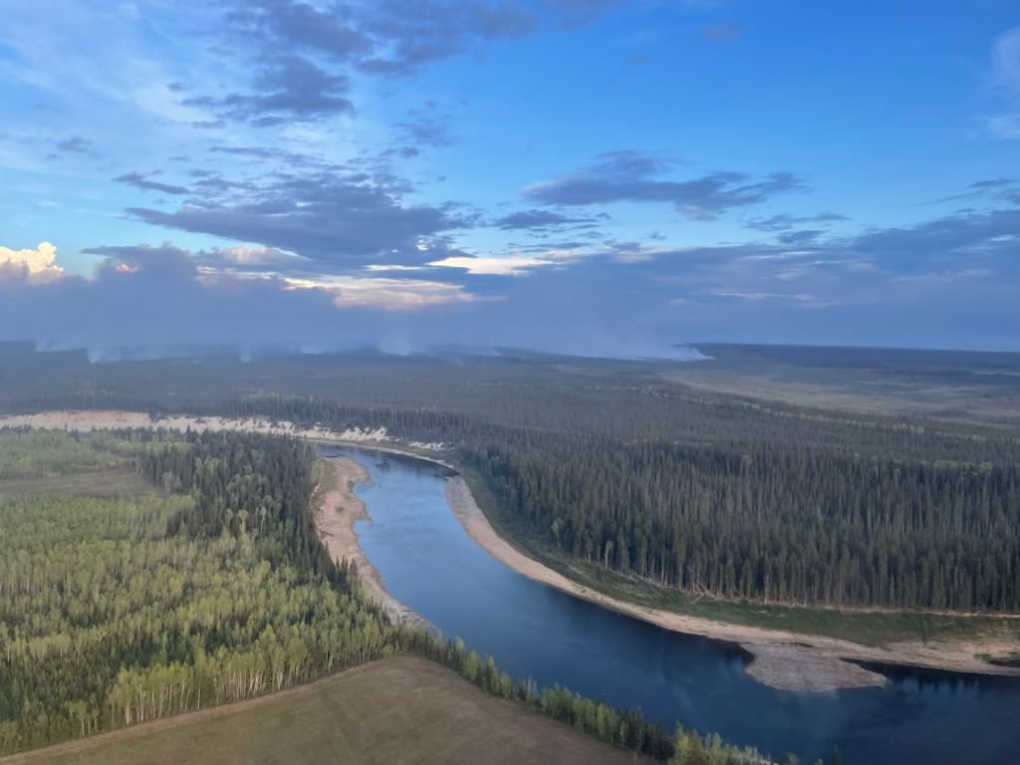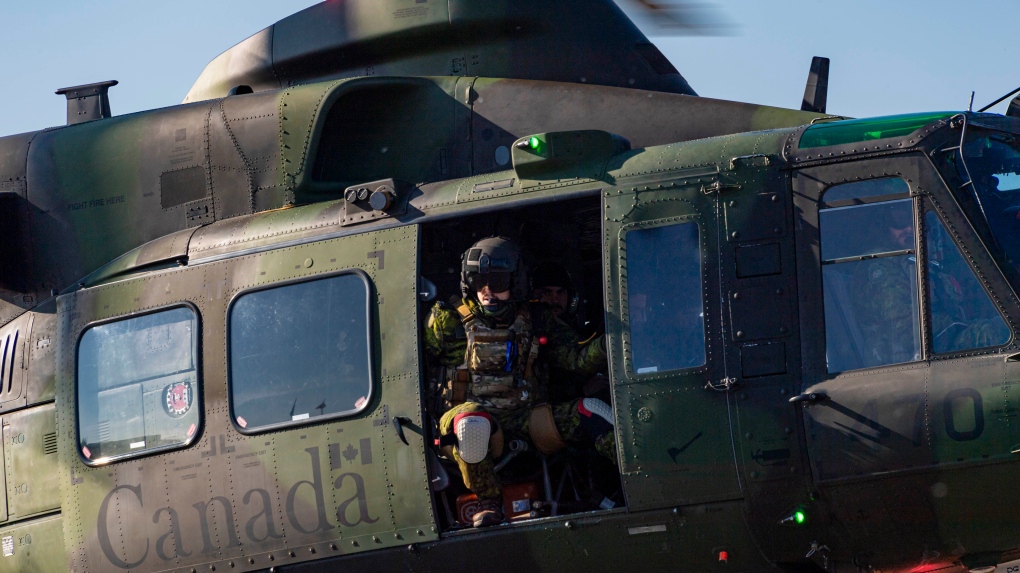
Ontario to ban use of cellphones in school classrooms starting in September
Ontario is introducing a suite of measures that will crack down on cellphone use and vaping in schools.
The Yellowknife evacuation order is being lifted at 11 a.m. MDT allowing residents home after weeks away due to wildfires.
A sense of normalcy is slowly returning to the community, Yellowknife's Mayor Rebecca Atly said.
Latest updates:
Children can be heard laughing and fresh air is rolling into the capital of the Northwest Territories on Wednesday.
"It was the first time I've heard kids laughing after three weeks, at a park outside of city hall," Atly told CTV News Channel on Wednesday. "Before that, it was kind of three weeks of adults working, it was just an industrious town."
Essential workers were called back to the city last week to set up services that were halted. On Wednesday, some residents will head home.
"It's a big sigh of relief, being able to get folks to start coming home today. But of course, it will take a number of days," Atly said.
The mayor hopes the return won't encounter any hiccups like when a food truck hit a power line last week, taking out power from the community of Fort Providence.
"It's a lot of logistics getting out and getting back in, but hoping — fingers crossed — for a smooth day," she said.
Some residents with medical conditions and late-term pregnancies will have to wait a few extra days to ensure services are set up completely.
Students are tentatively expected to start school on Sept. 14, the mayor said.
"It's been incredibly difficult, and I know it's not only financially draining but emotionally," Atly said. "It's been a traumatic time to be displaced from your home, so to reach out for counselling services…We'll continue to build back as a community…It will be tough and it will take a bit of time to recover."
After nearly three stressful weeks, Yellowknife building engineer William Gagnon is looking forward to being back home.
He was one of the first to leave because of a wildfire spreading toward the territorial capital on Aug. 16.
"I've been out for three weeks just jumping around on people's couches," he said. "I think this has brought me a pretty good understanding of how people can sink into homelessness."
He's expecting a "stinky fridge" when he returns.
Gagnon fled to Vancouver and has been staying with friends. He told CTV's Your Morning on Wednesday he's been feeling a lot of anxiety about the situation.
About two weeks into the evacuation, Gagnon realized his insurance coverage was running out to cover hotel stays.
"To be pushed out of your home because of climate change like this…it feels pretty much like 2023," he said.
 View from a plane of the Hay River wildfire burning in the distance. (Government of the Northwest Territories)
View from a plane of the Hay River wildfire burning in the distance. (Government of the Northwest Territories)
On Wednesday at 3 p.m. MDT Gagnon and other evacuees will board a flight to Yellowknife.
"I would love blue sky, no smoke and just be able to go running outside in the park next to my house," Gagnon said. Government officials say people returning need to be self-reliant for at least 72 hours.
"I'm gonna go to the grocery store here in Vancouver and pack an additional bag and put it on a plane," Gagnon said. "To me, this is highlighting the fact that we're highly dependent on supply chains…This is another impact of climate change. So I'll be bringing a big bag full of cheese on the plane. And then I think I'll find myself with a lot of patience."
Many residents were flown out by the Canadian Armed Forces (CAF) when the 20,000-person city was evacuated, but this time around evacuees will not be aided by CAF.
In an email on Wednesday, CAF said it will not be extending further assistance to the Northwest Territories.
"While wildfires continue with the N.W.T., they are now deemed actionable by territorial resources," the email reads. "As such, following 3 weeks of assistance, the CAF support to N.W.T. is drawing down. CAF members will be returning to their home units in the coming days."
 Corporal Dan Watkins, of 408 Tactical Helicopter Squadron, opens the door of a CH-146 Griffon during landing procedures at the 440 Transport Squadron hangar in Yellowknife in support of Operation LENTUS 23-07 on August 23, 2023. (Sailor First Class Patrice Harvey, Canadian Armed Forces)
Corporal Dan Watkins, of 408 Tactical Helicopter Squadron, opens the door of a CH-146 Griffon during landing procedures at the 440 Transport Squadron hangar in Yellowknife in support of Operation LENTUS 23-07 on August 23, 2023. (Sailor First Class Patrice Harvey, Canadian Armed Forces)
The Air Task Force assisted with the evacuation of 430 people and personnel, while about 350 members of the Land Task Force were deployed to Yellowknife and Hay River to assist with creating firebreaks, moving brush and dousing hot spots.
"As this time, there has been no request for assistance from the CAF to help support return flights to Yellowknife," the CAF said.
Many people in the South Slave region remain under an evacuation order on Wednesday, as fires continue to inch closer.
In Hay River, one fire about 4,656 kilometres in size is about half a kilometre from the town's hospital.
Temperatures have cooled across the region and some humidity has returned after some rain over the long weekend, however, an update on the N.W.T. fire website warns drought risk is still high.
"Rainfall relief is already beginning to fade in the area," the online update on Tuesday reads. "There is still a high level of risk to Hay River and the surrounding area – where fire has reached many populated areas."
Communities across the southern half of the territory have been experiencing extreme drought, which has allowed fires to burn quickly and underground.
According to the update, the drought code for Hay River is at 700. Anything above 400 is "extreme," it says. Similar conditions can be seen in Fort Smith, a community along the Alberta border in N.W.T.
 Crews continue to battle the fire in Fort Smith even after cooling temperatures. (Alberta wildfire)
Crews continue to battle the fire in Fort Smith even after cooling temperatures. (Alberta wildfire)
Some precipitation was seen in the community over the weekend, which allowed firefighters to douse the flames.
However, drought has been so severe in the area this summer that even with some rain fires are still burning. According to a Tuesday update, the drought code for Fort Smith is over 1,100, which is the highest ever seen on record.
"In August, the area around Fort Smith usually receives an average of around 64 mm of precipitation – this year the area received 5 mm in total," the update reads.
Drought allows the fire to seep underground burning what is called a "duff layer" of the soil usually comprised of dead leaves and other fuels.
When the fire burns deep it can harm the roots of trees making it unsafe for ground crews. In Fort Smith, some firefighters have found "ash pits" about two to three feet deep.
"It takes a lot of intense, precise work to extinguish a hot area of fire burning that deep," an update reads.
With files from the Canadian Press.

Ontario is introducing a suite of measures that will crack down on cellphone use and vaping in schools.
Zendaya and castmates Mike Faist and Josh O’Connor have been on a globetrotting press tour to get the word out about Italian director Luca Guadagnino's original film, which opened in 3,477 locations in the U.S. and Canada.
Quebec will invest $603 million over five years to counter the decline of French in the province, French Language Minister Jean-Francois Roberge announced Sunday.
The Canadian Food Inspection Agency has issued a recall for a specific chocolate brand sold in Ontario and Quebec.
Raneem, 10, lives with a neurological condition and liver disease and needs Cholbam, a medication, for a longer and healthier life.
Ontario is now home to an invasive and toxic worm species that can grow up to three feet long and can be dangerous to small animals and pets.
One person has been charged with second-degree murder in connection with the death of a man who fell from a balcony following an altercation inside a Toronto apartment building.
Dozens of people raised their arms in the fascist salute and shouted a fascist chant during ceremonies Sunday to honor Italian dictator Benito Mussolini on the 79th anniversary of his execution.
The 2024 federal budget announced on April 16 included plans to introduce “halal mortgages” as a way to increase access to home ownership.

As if a 4-0 Edmonton Oilers lead in Game 1 of their playoff series with the Los Angeles Kings wasn't good enough, what was announced at Rogers Place during the next TV timeout nearly blew the roof off the downtown arena.
Mounties in Nanaimo, B.C., say two late-night revellers are lucky their allegedly drunken antics weren't reported to police after security cameras captured the men trying to steal a heavy sign from a downtown business.
A property tax bill is perplexing a small townhouse community in Fergus, Ont.
When identical twin sisters Kim and Michelle Krezonoski were invited to compete against some of the world’s most elite female runners at last week’s Boston Marathon, they were in disbelief.
The giant stone statues guarding the Lions Gate Bridge have been dressed in custom Vancouver Canucks jerseys as the NHL playoffs get underway.
A local Oilers fan is hoping to see his team cut through the postseason, so he can cut his hair.
A family from Laval, Que. is looking for answers... and their father's body. He died on vacation in Cuba and authorities sent someone else's body back to Canada.
A former educational assistant is calling attention to the rising violence in Alberta's classrooms.
The federal government says its plan to increase taxes on capital gains is aimed at wealthy Canadians to achieve “tax fairness.”